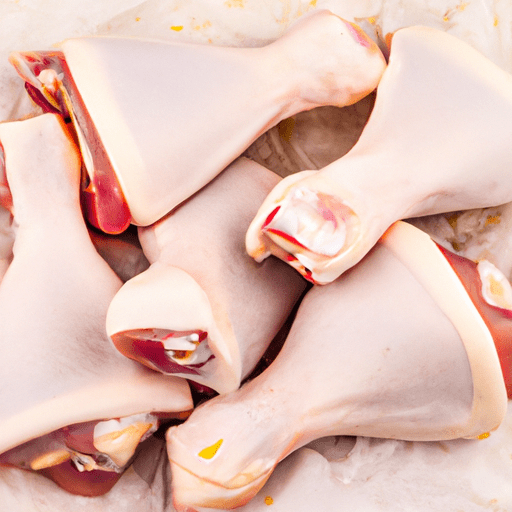Unveiling the Versatile Delight: Bone-In Skinless Chicken Thighs
When it comes to flavor, versatility, and ease of cooking, bone-in skinless chicken thighs reign supreme. They are a favorite among home cooks and professional chefs alike and for good reason. In this post, we’ll take a deep dive into the world of bone-in skinless chicken thighs, exploring their taste profile, common uses in cooking, nutritional value, and intriguing historical background.
Taste and Texture
Bone-in skinless chicken thighs offer a succulent and moist meat that is unrivaled by other cuts. The dark meat of the thigh boasts a rich, deep flavor that presents a beautiful balance between tenderness and juiciness. This combination makes them exceptionally forgiving to cooks, as they are less prone to drying out compared to leaner cuts of chicken. With the bone left intact, these thighs have enhanced natural flavor due to the marrow, adding an extra depth that elevates your culinary creations.
Common Uses in Cooking
Bone-in skinless chicken thighs are a highly versatile cut that lends itself well to various cooking methods. They can be baked, grilled, pan-fried, or even stewed, offering endless possibilities for culinary creativity.
One popular method is braising, where the thighs are seared to achieve a golden crust and then simmered in a flavorful liquid until tender. This method helps create succulent, fall-off-the-bone meat that is perfect for hearty stews and comforting winter dishes.
Grilling bone-in skinless chicken thighs imparts a smoky char that envelopes the meat, creating a fantastic contrast of flavors. They can be marinated beforehand, allowing the flavors to penetrate the meat and enhance its taste. These grilled thighs work wonders in salads, wraps, taco fillings, or simply enjoyed on their own as a protein-packed main course.
Nutritional Value
Bone-in skinless chicken thighs offer not only a delightful taste but also a range of nutritional benefits. While they contain slightly more fat than boneless skinless chicken breasts, they are packed with essential nutrients. Here’s a breakdown of their nutritional value per 100 grams:
- Protein: Approximately 21 grams, making it a great source of this macronutrient for muscle support and repair.
- Fat: Around 12 grams, with a mix of both saturated and unsaturated fats.
- Vitamins: Rich in B vitamins, including niacin and vitamin B6, contributing to a healthy metabolism.
- Minerals: Contains iron, zinc, and selenium, important for overall health and immunity.
By incorporating bone-in skinless chicken thighs into your meals, you can enjoy a nutrient-dense protein source that nourishes your body.
Fascinating History and Facts
Bone-in skinless chicken thighs have long been a valuable part of global cuisines. In Japanese cuisine, they are used to prepare popular dishes like yakitori, which are grilled chicken skewers often served with a savory glaze. In Southern cuisine, they are a key ingredient in classic dishes such as chicken and waffles or fried chicken, showcasing the versatility of this cut across different cultures.
Interestingly, bone-in skinless chicken thighs were not commonly seen outside of their countries of origin until the mid-20th century. As transportation and global food trade advanced, these delicious cuts became more widely available, leading to their popularity skyrocketing in kitchens worldwide.
Conclusion
Bone-in skinless chicken thighs are a culinary treasure offering fantastic flavor, tenderness, and culinary flexibility. Whether you plan to braise, grill, bake, or stew them, their versatility ensures a delightful meal every time. With their rich history and undeniable nutritional value, bone-in skinless chicken thighs are a true essential in any home cook’s repertoire. Embrace the flavorful possibilities and let these delicious thighs inspire you in the kitchen!
Bone-in Skinless Chicken Thighs
Origin:
- Chicken thighs come from chickens, which are domesticated fowls that have descended from the red junglefowl in Southeast Asia.
- Chickens were first domesticated around 5,000 years ago, primarily for cockfighting. Over time, their utility shifted to their meat and eggs, leading to the development of various chicken breeds.
Common Uses:
- Bone-in skinless chicken thighs are versatile and commonly used in various culinary preparations worldwide.
- They can be baked, roasted, grilled, pan-fried, or used in stews, curries, casseroles, soups, and stir-fries.
- The rich flavor and tender, juicy texture of chicken thighs make them a popular choice for many dishes.
Nutritional Benefits:
- Bone-in skinless chicken thighs are a good source of high-quality protein, which is essential for cell growth, repair, and maintenance.
- They contain significant amounts of vitamins and minerals, including vitamin B6, vitamin B12, iron, zinc, and selenium.
- Chicken thighs are also a source of healthy fats, with most of the fat being unsaturated. However, their fat content can vary depending on the cooking method.
Unique Properties and Historical Significance:
- The bone-in skinless chicken thighs retain more moisture and flavor compared to other cuts. The bone helps in distributing heat evenly while cooking, resulting in a more tender and juicy meat.
- Chicken thighs have been a part of various cuisines throughout history. For example, in the Middle Ages, chicken thighs were considered a delicacy in European aristocratic circles.
- In recent decades, due to their flavor and versatility, bone-in skinless chicken thighs have gained popularity in both home cooking and restaurant menus worldwide. They have become a staple in many cultural dishes.




Use the share button below if you liked it.
It makes me smile, when I see it.